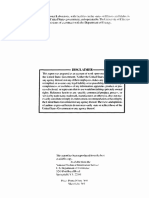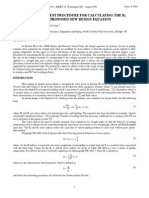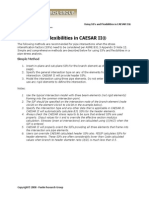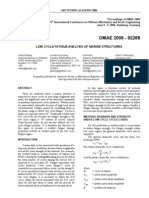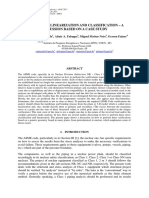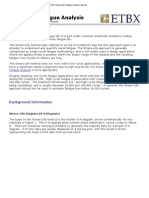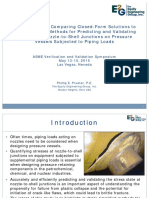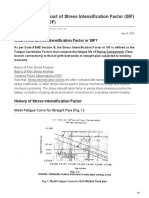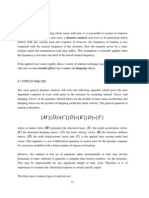Markl SIFs & Asme Viii
Markl SIFs & Asme Viii
Uploaded by
Desmond ChangCopyright:
Available Formats
Markl SIFs & Asme Viii
Markl SIFs & Asme Viii
Uploaded by
Desmond ChangCopyright
Available Formats
Share this document
Did you find this document useful?
Is this content inappropriate?
Copyright:
Available Formats
Markl SIFs & Asme Viii
Markl SIFs & Asme Viii
Uploaded by
Desmond ChangCopyright:
Available Formats
Markl, SIFs, and ASME VIII-2 Fatigue Design
Markl, SIFs, and ASME VIII-2 Fatigue Design
Did you know that PRG has the only automated FEA Stress Intensification Factor (SIF)
calculator in the world?
PRG software has been automatically calculating SIFs for varieties of piping components for
more than fifteen years.
This brief article addresses the question of "What are SIFs, where did they come from, and
how do they relate to ASME Section VIII-2 fatigue designs?"
Since B31.3 2007 (and earlier) references finite element methods and ASME Section VIII-2
fatigue methods in Appendices 4 and 5, this is information that should be understood by
every senior piping designer.
Markl, FEA, and Div 2. Appendix 5
One benefit of PRG software is the automated calculation of piping stress intensification
factors (SIFs). SIFs are automatically calculated in FE-SIF, Nozzle/PRO, and FE/Pipe. In fact,
there is no other FEA software in the world that provides automatic SIF calculations.
FE-SIF is specially designed for these calculations and intended to be an “everyday product”
for piping engineers to utilize in concert with their usual piping analysis software.
This topic will provide a brief introduction to how SIFs are calculated, how they relate to
ASME Section VIII Division 2 fatigue design, and where did SIFs come from.
A Stress Intensification Factor (SIF) is defined as the ratio between the peak stress and
average stress in a given component:
SIF = Actual Peak Stress / Nominal Stress in Part
A. R. C. Markl and his team (1950’s) developed the original SIFs still used in ASME piping
Codes today.
In his study, Markl determined that girth butt-welds typically resulted in stresses
approximately 1.7 to 2.0 times the stress in non-welded piping. As a result, all of the piping
codes have been “base lined” to include the factor of 2.0 for girth welds:
Actual (Peak Stress) due to Moment M
B31.3 SIF = Stress in Girth Butt Weld due to Moment
M
OR
Actual (Peak Stress) due to Moment M
B31.3 SIF =
2 * (Moment M) / (Section Modulus Z)
In terms of ASME Section 8, Division 2, Appendix 5 and finite element analysis (FEA) work,
we could use the following equation interchangeably with the previous equations:
Copyright© 2008 - Paulin Research Group
Markl, SIFs, and ASME VIII-2 Fatigue Design
Range of Peak Stress due to M
SIF =
2 * (Moment M) / (Section Modulus Z)
2 * (Pl+Pb+Q+F)
=
2 * (M / Z)
OR
Alternating Peak Stress due to M
SIF =
(Moment M) / (Section Modulus Z)
(Pl+Pb+Q+F)
=
(M / Z)
The peak alternating stress (PL+PB+Q+F) is usually determined from finite element
analysis. Normally, the peak stress is the product of the secondary stress and a fatigue
strength reduction factor (FSRF). For instance:
PL+PB+Q+F = (PL+Pb+Q)*FSRF / 2.0
FSRFs are determined from testing or taken from references such as WRC 432.
As discussed in NUREG/CR-3243, the mean curve fitted to Markl’s fatigue test data gives a
relationship between the stress range in a butt weld pipe and the number of cycles to cause
a thru-wall fatigue failure:
i * M / Z = Sf = 490000 * (N)-0.20 (Equation 1)
where
i = stress intensification factor
M = bending moment
Z = section modulus
N = expected number of cycles
Sf = allowable cycling stress
The mean curve described by Equation 1 is shown in the figure below.
Copyright© 2008 - Paulin Research Group
Markl, SIFs, and ASME VIII-2 Fatigue Design
Equation 1 has been normalized based on the peak stress range in a girth butt-weld (i.e. i =
1.0). As a result, there is an inherent factor on the peak stress range “S” of 0.50. All peak
stresses given by Markl SIFs are half of their actual values due to Markl’s use of girth butt-
welds as a baseline.
The factor of two makes the alternating peak stresses used in Division 2 Appendix 4 & 5
very easy to implement in terms of the Markl failure criteria (Equation 1). One could
conclude that by using a factor of 0.50 on peak stress, Markl has essentially reduced the
stress range to an alternating stress component. Using this conclusion, we can use Division
2 Appendix 4 & 5 peak stresses with the following equation:
Pl+Pb+Q+F = 490000 * (N)-0.20 (Equation 2)
N = (Pl+Pb+Q+F / 490000)-0.20 (Equation 3)
Equation 2 gives the ASME Section 8, Division 2 alternating peak stress (Pl+Pb+Q+F) that
would cause a through-wall fatigue failure with a 50% probability of failure.
Equation 3 gives the number of cycles to failure for a given ASME Section 8, Division 2
alternating peak stress (Pl+Pb+Q+F).
FE-SIF automates these calculations and provides accurate SIFs for all piping components,
regardless of their geometry or design.
Copyright© 2008 - Paulin Research Group
You might also like
- MR Surendra Kumar RinkDocument2 pagesMR Surendra Kumar RinkLavi SharmaNo ratings yet
- Simultaneous Operations (SIMOPS)Document19 pagesSimultaneous Operations (SIMOPS)Desmond Chang82% (11)
- VibrationControl CATALOGO SOPORTES PDFDocument12 pagesVibrationControl CATALOGO SOPORTES PDFMilena Lemus FonsecaNo ratings yet
- Manta To Richmond SIMOPS Risk Matrix FINALDocument1 pageManta To Richmond SIMOPS Risk Matrix FINALDesmond Chang50% (2)
- Welding HabitatDocument12 pagesWelding HabitatDesmond Chang100% (4)
- A Finite Element-Based InvestigationDocument7 pagesA Finite Element-Based InvestigationSteve IpNo ratings yet
- Bonney Forge Sifs Various FittingsDocument45 pagesBonney Forge Sifs Various FittingsKevinNo ratings yet
- Examples Applying Fea Results With Caesar II Models Webinar PDFDocument36 pagesExamples Applying Fea Results With Caesar II Models Webinar PDFkorbelNo ratings yet
- Recent Developments in Piping Vibration Screening LimitsDocument15 pagesRecent Developments in Piping Vibration Screening Limitstgpg7fk758No ratings yet
- RatchingDocument60 pagesRatchingSubhadip SadhukhanNo ratings yet
- Estimation of SIF by Mumerical MethodDocument21 pagesEstimation of SIF by Mumerical Methodworkineh gebeyehuNo ratings yet
- B2 Stress IndexDocument12 pagesB2 Stress IndexParilla13No ratings yet
- Volume 1Document277 pagesVolume 1c prarthnaNo ratings yet
- Web Using FesifDocument5 pagesWeb Using FesifjtpmlNo ratings yet
- The Finite Element Method and Applications in Engineering Using Ansys®Document5 pagesThe Finite Element Method and Applications in Engineering Using Ansys®sivaraju22No ratings yet
- W044Rev1 PDFDocument41 pagesW044Rev1 PDFTONNo ratings yet
- Chapter 8 - LoadingDocument8 pagesChapter 8 - LoadingmuhdqasimNo ratings yet
- Nozzle Stiffness and Stress Computation Using A Parametrically Controlled Finite Element Modeling ApproachDocument4 pagesNozzle Stiffness and Stress Computation Using A Parametrically Controlled Finite Element Modeling ApproachkysucoNo ratings yet
- Flexmen: Register User Forum List Calendar Active Topics FaqDocument19 pagesFlexmen: Register User Forum List Calendar Active Topics FaqParilla13No ratings yet
- Pressurevessel 1Document22 pagesPressurevessel 1mohanrao1976No ratings yet
- FEA Ansys Axisymmetric Skirt ExampleDocument16 pagesFEA Ansys Axisymmetric Skirt Examplejohn_max03No ratings yet
- 408 Caesar II TrainingDocument5 pages408 Caesar II TrainingRamesh K RameshNo ratings yet
- CAESAR II MAX Combination LoadCaseDocument2 pagesCAESAR II MAX Combination LoadCasePrashant Chauhan0% (1)
- Detailed Fea of Locally Thinned Pipe Bends: Usama Abdelsalam & DK VijayDocument9 pagesDetailed Fea of Locally Thinned Pipe Bends: Usama Abdelsalam & DK VijayAnonymous 1hOgJqwZuzNo ratings yet
- Correction Factors For ASME ANSI-OM3 Stress-Velocity RelationshipDocument8 pagesCorrection Factors For ASME ANSI-OM3 Stress-Velocity RelationshipMPhamNo ratings yet
- Power of Symbol KeysDocument49 pagesPower of Symbol KeysHùng Mạnh NguyễnNo ratings yet
- Strength of Materials - Deflection of Beams - Hani Aziz AmeenDocument25 pagesStrength of Materials - Deflection of Beams - Hani Aziz AmeenHani Aziz AmeenNo ratings yet
- 9 - The Finite Volume Method For Unsteady ProblemsDocument8 pages9 - The Finite Volume Method For Unsteady ProblemsAbaziz Mousa OutlawZzNo ratings yet
- Improvements in Modeling and Evaluating Branch Connections: Caesar IiDocument23 pagesImprovements in Modeling and Evaluating Branch Connections: Caesar IiFSAAVEDRAFNo ratings yet
- Sustained Stress Indices (SSI) in The B31.3 2010 EditionDocument9 pagesSustained Stress Indices (SSI) in The B31.3 2010 Editiont_rajith1179100% (2)
- Review of Fatigue Strength Assessment ofDocument18 pagesReview of Fatigue Strength Assessment ofNrl SyafiniNo ratings yet
- Low Cycle Fatigue AnalysisDocument6 pagesLow Cycle Fatigue AnalysisChirag SanghaniNo ratings yet
- Design by AnalysisDocument22 pagesDesign by AnalysisJEELE77No ratings yet
- Calculation of Dynamic Stress Intensity Factors For Pipes During Crack Propagation by Dynamic Finite Element AnalysisDocument10 pagesCalculation of Dynamic Stress Intensity Factors For Pipes During Crack Propagation by Dynamic Finite Element AnalysisMarcelo Varejão CasarinNo ratings yet
- 2010 Elementbibliothek LSDyna Cadfem PDFDocument78 pages2010 Elementbibliothek LSDyna Cadfem PDFvanloc85No ratings yet
- FEM ANSYS Mixed Heat Transfer PDFDocument10 pagesFEM ANSYS Mixed Heat Transfer PDFSankhadeep BhattacharyyaNo ratings yet
- Alternating Stress in ANSYS (Part 1: Principal Stress) : We Make Innovation WorkDocument38 pagesAlternating Stress in ANSYS (Part 1: Principal Stress) : We Make Innovation WorkMetin MehelNo ratings yet
- 243 FatigueAnalysisofPipingSystemsonTopsidesofFPSOSystemsDocument5 pages243 FatigueAnalysisofPipingSystemsonTopsidesofFPSOSystemsSatish KenguvaNo ratings yet
- Asme Stress Linearization and Classification - A Discussion Based On A Case StudyDocument12 pagesAsme Stress Linearization and Classification - A Discussion Based On A Case Studysagar1503No ratings yet
- Fluid MechanicsDocument9 pagesFluid MechanicsRagh AhmedNo ratings yet
- Vessel Description: Pressure Vessel Engineering, LTDDocument40 pagesVessel Description: Pressure Vessel Engineering, LTDSivateja NallamothuNo ratings yet
- Pipe Fea Using AnsysDocument14 pagesPipe Fea Using AnsysTONNo ratings yet
- ETBX Stress-Life Fatigue Analysis ModuleDocument11 pagesETBX Stress-Life Fatigue Analysis ModuleLeonardo Da Rosa Gonçalves100% (1)
- WRC 107 WRC 297 Co MP PDFDocument11 pagesWRC 107 WRC 297 Co MP PDFIqbal Muhammad100% (1)
- ANSYS Analysis of Single Phase Induction Motor - Hani Aziz AmeenDocument74 pagesANSYS Analysis of Single Phase Induction Motor - Hani Aziz AmeenHani Aziz Ameen50% (2)
- ASME Section VIII, Division 2 Elastic Analysis Discussion - Collapse Vs Ratcheting - BechtDocument2 pagesASME Section VIII, Division 2 Elastic Analysis Discussion - Collapse Vs Ratcheting - BechtRaul Alfredo Caballero ColmenaresNo ratings yet
- High Pressure Flange Design 236313199Document133 pagesHigh Pressure Flange Design 236313199Karthikeyan VisvakNo ratings yet
- Allowable StressesDocument2 pagesAllowable Stressesananyo_senguptaNo ratings yet
- PV Newsletter - Volume 2012 Issue 8Document8 pagesPV Newsletter - Volume 2012 Issue 8SachinNo ratings yet
- Featools Intro Webinar Scripted For IntergraphDocument58 pagesFeatools Intro Webinar Scripted For IntergraphJimmy Alexander Avila100% (1)
- Piping Flexibility Analysis by A.R.C.Markl PDFDocument23 pagesPiping Flexibility Analysis by A.R.C.Markl PDFhubert_velten100% (2)
- Jun 97Document349 pagesJun 97homer hullezaNo ratings yet
- Hechmer 1991Document7 pagesHechmer 1991rahulNo ratings yet
- Static Analysis of Piping SystemsDocument37 pagesStatic Analysis of Piping SystemsLeandro Vargas100% (1)
- Design by Rule-Design by Analysis PDFDocument18 pagesDesign by Rule-Design by Analysis PDFChandra ClarkNo ratings yet
- Nozzle StressDocument25 pagesNozzle StressvamsiNo ratings yet
- PADT ANSYS Fastener Simulation Part1Document22 pagesPADT ANSYS Fastener Simulation Part1isma_nashNo ratings yet
- Probabilistic Physics of Failure Approach to Reliability: Modeling, Accelerated Testing, Prognosis and Reliability AssessmentFrom EverandProbabilistic Physics of Failure Approach to Reliability: Modeling, Accelerated Testing, Prognosis and Reliability AssessmentNo ratings yet
- Importance Impact of Stress Intensification Factor SIF in Piping With PDFDocument8 pagesImportance Impact of Stress Intensification Factor SIF in Piping With PDFBogdan ChivulescuNo ratings yet
- Importance & Impact of Stress Intensification Factor (SIF) : A PresentationDocument6 pagesImportance & Impact of Stress Intensification Factor (SIF) : A PresentationRomner Cordova100% (1)
- Elastic Stress Analysis For Heat Exchanger Channel Head For Protection Against Plastic Collapse and Protection Against Local Failure (FEA)Document8 pagesElastic Stress Analysis For Heat Exchanger Channel Head For Protection Against Plastic Collapse and Protection Against Local Failure (FEA)kingstonNo ratings yet
- Sample21 SpreadsheetDocument20 pagesSample21 SpreadsheetSivateja Nallamothu100% (1)
- Steel End/Base Plate & Anchor Bolts Analysis & DesignDocument6 pagesSteel End/Base Plate & Anchor Bolts Analysis & DesignRey GonzalesNo ratings yet
- What Is A Stress Intensification FactorDocument7 pagesWhat Is A Stress Intensification FactorMahendra RathoreNo ratings yet
- Induction BendsDocument16 pagesInduction BendsDesmond Chang100% (1)
- Stressman Engineering - Study - Stresses in Pipe Bends With Different Angles R2Document4 pagesStressman Engineering - Study - Stresses in Pipe Bends With Different Angles R2Desmond ChangNo ratings yet
- Stressman Engineering - Study - Stresses in Branch Connections at Different AnglesDocument7 pagesStressman Engineering - Study - Stresses in Branch Connections at Different AnglesDesmond ChangNo ratings yet
- PFD Calculation Program: #Value! #Value! #Value!Document4 pagesPFD Calculation Program: #Value! #Value! #Value!Desmond ChangNo ratings yet
- Lopa Workbook Sept 2005Document12 pagesLopa Workbook Sept 2005Desmond Chang100% (1)
- SIL vs. Log (Distance) : TEMPLATE For SIL Field Lab DataDocument2 pagesSIL vs. Log (Distance) : TEMPLATE For SIL Field Lab DataDesmond ChangNo ratings yet
- Weld End Preparation at Unequal Wall ThicknessesDocument4 pagesWeld End Preparation at Unequal Wall ThicknessesDesmond ChangNo ratings yet
- Standards IndexDocument32 pagesStandards IndexDesmond Chang100% (1)
- Piping - Materials - Elbows and Bends - Reducers - PE & ROTO Lined Carbon Steel PipingDocument52 pagesPiping - Materials - Elbows and Bends - Reducers - PE & ROTO Lined Carbon Steel PipingDesmond Chang100% (1)
- Ansys - DynamicsDocument13 pagesAnsys - DynamicsNono_geotecNo ratings yet
- ANSYS Modal AnalysisDocument40 pagesANSYS Modal AnalysisDesmond Chang100% (1)
- Permit To Work Flow ChartDocument2 pagesPermit To Work Flow ChartDesmond Chang100% (1)
- PDMS Update AvevaDocument21 pagesPDMS Update AvevaDesmond ChangNo ratings yet
- The Basics of Arc WeldingDocument35 pagesThe Basics of Arc WeldingDesmond ChangNo ratings yet
- A Review On Various Methods of Transformer ProtectionDocument5 pagesA Review On Various Methods of Transformer ProtectionEditor IJTSRDNo ratings yet
- VB 6.0 ThesisDocument5 pagesVB 6.0 Thesisafjrqxflw100% (2)
- AADvance Controller System BuildDocument161 pagesAADvance Controller System BuildFer EscalonaNo ratings yet
- Kizashi Accessories Catalogue 10-2010Document11 pagesKizashi Accessories Catalogue 10-2010Даниил ЯнковскийNo ratings yet
- Introduction DietkareDocument14 pagesIntroduction DietkareShreehariRbhatNo ratings yet
- Kolida SDE 28S Echo Sounder User Manual 20200806Document80 pagesKolida SDE 28S Echo Sounder User Manual 20200806sklshakil8298No ratings yet
- TA-143-D00-G-TD005 - 0 - Employer's Requirements PDFDocument78 pagesTA-143-D00-G-TD005 - 0 - Employer's Requirements PDFshareyhouNo ratings yet
- Biostar: H110MH PRO D4 MotherboardDocument6 pagesBiostar: H110MH PRO D4 MotherboardPrivate music hackerNo ratings yet
- DB1 - Data ViewDocument4 pagesDB1 - Data ViewRA DRONESNo ratings yet
- Manual FfmpegDocument298 pagesManual Ffmpeguno_wosNo ratings yet
- Binary Search TreeDocument14 pagesBinary Search TreeSanjay GowdNo ratings yet
- User Manual 20210609 v1 C009 ASC 2400 IM ENG 210527 V3 5294656Document8 pagesUser Manual 20210609 v1 C009 ASC 2400 IM ENG 210527 V3 5294656ieyhnapalconeteNo ratings yet
- Azure Virtual Desktop ManualDocument45 pagesAzure Virtual Desktop ManualThierry Vit100% (1)
- Improving Security Challeges of Atm System in Commercial Bank of Ethiopia: The Case of Wolaita Zone, Sodo CityDocument21 pagesImproving Security Challeges of Atm System in Commercial Bank of Ethiopia: The Case of Wolaita Zone, Sodo CityInternational Journal of Application or Innovation in Engineering & ManagementNo ratings yet
- Online Registration System Literature ReviewDocument8 pagesOnline Registration System Literature Reviewfvdra0st100% (1)
- 209Document4 pages209Nezer VergaraNo ratings yet
- Rust As Functional Programming LanguageDocument19 pagesRust As Functional Programming Languageeternalmay33No ratings yet
- Computer On Office Automation Model Test-1 (Unit-1, 2.1, 3, 7)Document2 pagesComputer On Office Automation Model Test-1 (Unit-1, 2.1, 3, 7)Kavitha Saravana KumarNo ratings yet
- Abap ProjectsDocument3 pagesAbap Projectsprakash_tseNo ratings yet
- Metal Clad Vs Metal EnclosedDocument1 pageMetal Clad Vs Metal EnclosedCarlos A. Carpio Cárdenas100% (1)
- Project Report On Crop Yield PredictionDocument71 pagesProject Report On Crop Yield PredictionAyush singhNo ratings yet
- Course Registration SystemDocument8 pagesCourse Registration Systemnitika50% (2)
- 6 HR Officer Interview QuestionsDocument7 pages6 HR Officer Interview QuestionsJenyll MabborangNo ratings yet
- Reading Sample: "Extending SAP S/4HANA" Index The AuthorsDocument27 pagesReading Sample: "Extending SAP S/4HANA" Index The Authorschandra9000No ratings yet
- Metal Detecting RobotDocument3 pagesMetal Detecting RobotstarNo ratings yet
- Scripting Guide ServiceNow PDFDocument140 pagesScripting Guide ServiceNow PDFdivya karriNo ratings yet
- Exam Az 500 Microsoft Azure Security TechnologiesDocument7 pagesExam Az 500 Microsoft Azure Security TechnologiesAldo SENo ratings yet
- Statistical Analysis Using SasDocument46 pagesStatistical Analysis Using Saskabelo MotsepeNo ratings yet









